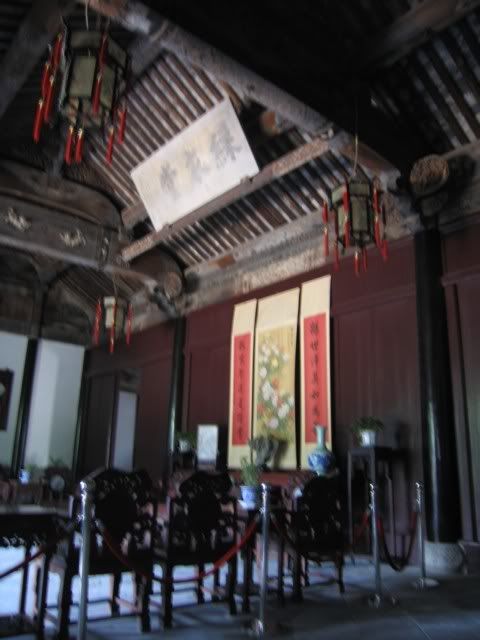I went to a few homes today. The first one I visited is that of the Weng family. They were easily the most prominent family in Changshu in the 19th century, with two members of their family earning the number one rank at the highest level exam in the land, and thus gaining the title of Zhuangyuan. There’s a gate to commemorate it.

Back in the way, these things were everywhere, especially in a town like Changshu, commemorating various things from high places in exams, to women who were chaste, to men who had fallen in battle, to…. you name it.
Since many members of this family reached high office, the family estate was obviously large. The main building is what is of the most interest, but it’s a house with 7 “jin”, which means 7 buildings on the central axis. A house would be considered large if it has 4 or 5 “jin”, so 7 is…. well, big. The main building was built in the Ming dynasty — sometime in the 16th century, if I remembered correctly. It’s very impressive.

(sorry for the shaky hand… it was very dark)

You can see the place is HUGE

With beautiful details
After spending a good hour there and actually lucked out on finding something useful for my work, I then went to the house where my grandfather grew up. It’s a very short walk from the Weng residence. Despite the fact that it’s supposedly a protected building for historical reasons:

The place is now occupied by at least a dozen families. After the communist took over most of these houses were given away to families that lacked a home, while the original family might’ve been kicked out or, at best, given a room in one corner of the house. Over time, it turned into this

You can see how the hall was built into — originally there was nothing obstructing the hall, but now they have put walls up on both sides, making it into a narrow alley while living in these concrete blocks. So much for conservation…
They do it in the courtyards too

You can see that inside… the primary structure is still pretty sturdy, but I think houses like this (which is the vast majority in the city) are a lost cause. It’ll be almost impossible to do anything about them, so any pretence of protection is really just a sham, I think. You can’t evict these people, who might’ve lived there for decades. It’s hard to tear down these walls — must be done carefully if you don’t want to destroy the old structure — and it’s simply too uneconomical.

Interestingly enough… every family had a well in their courtyard

And I think that was the primary source of water. They still use it — somebody was pulling up a bucket of water right before I took this picture. The nice thing was that they just let me walk in to take pictures. At least they didn’t try to kick me out.
I then went back to the Fangta park, where there’s a stone engraving garden — where they collected a lot of stone engravings from around the city and put them together, essentially saving them for posterity. It’s nice. Far too many of these are lost and some are very valuable historical documents. I was here for work, basically, as I wanted to see if I could find something useful here. This is what some of them look like

And then I ended the day with some tea, as that dull headache starts to set in. It’s called “Deyu Huocha”, or “Get Rain Living Tea”, literally. I suppose a better translation is “Tea that comes alive as it receives rain”. The selling point of this tea is that…. they are used for the national banquets at the Great Hall of the People, and also the leaves point UP. Meaning… the tip of the leaf, rather than pointing down as green tea often does, point up. You can see one of them in action.

The tea itself was just rather generic… nothing to write home about. A longjing is far better.

 RSS - Posts
RSS - Posts
1 response so far ↓
Anonymous // May 14, 2007 at 1:39 am |
Interesting stuff! Midwest America tends to be slightly less historically prominent so I love to hear about things such as this.
tb.